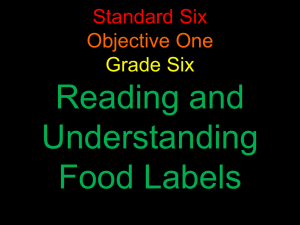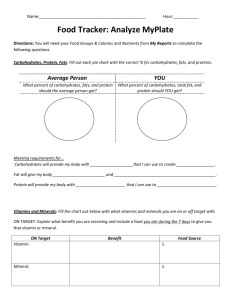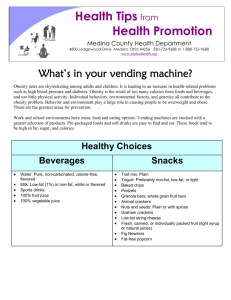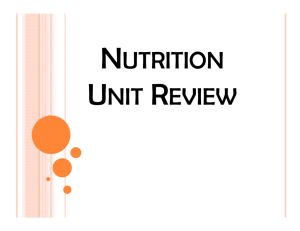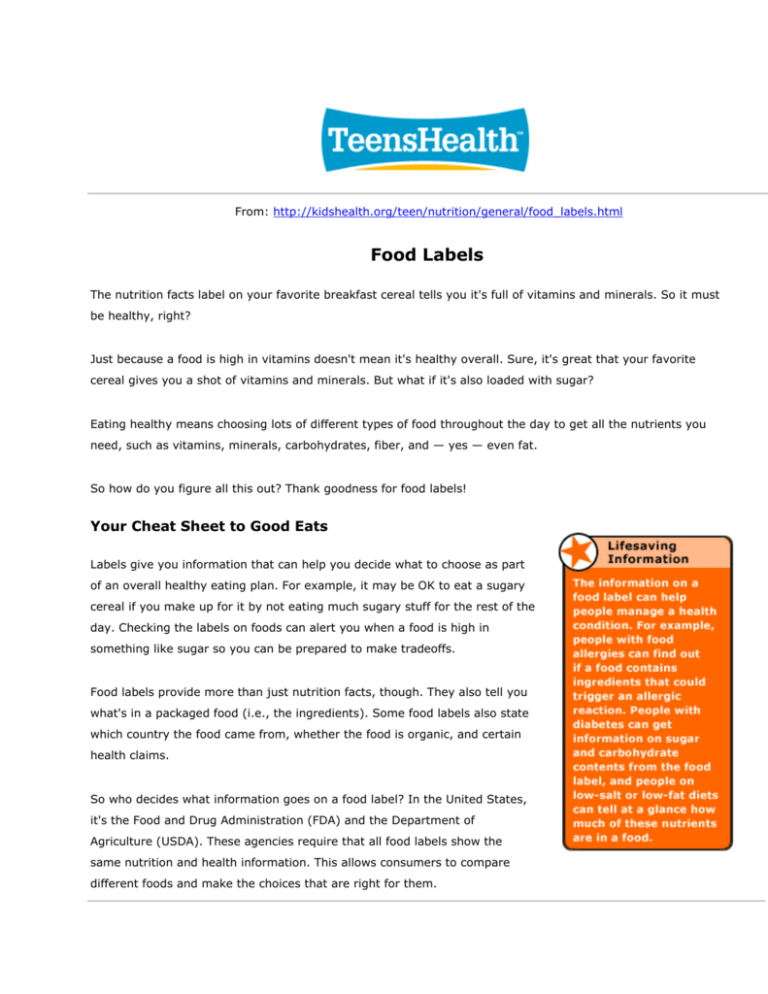
From: http://kidshealth.org/teen/nutrition/general/food_labels.html
Food Labels
The nutrition facts label on your favorite breakfast cereal tells you it's full of vitamins and minerals. So it must
be healthy, right?
Just because a food is high in vitamins doesn't mean it's healthy overall. Sure, it's great that your favorite
cereal gives you a shot of vitamins and minerals. But what if it's also loaded with sugar?
Eating healthy means choosing lots of different types of food throughout the day to get all the nutrients you
need, such as vitamins, minerals, carbohydrates, fiber, and — yes — even fat.
So how do you figure all this out? Thank goodness for food labels!
Your Cheat Sheet to Good Eats
Labels give you information that can help you decide what to choose as part
of an overall healthy eating plan. For example, it may be OK to eat a sugary
cereal if you make up for it by not eating much sugary stuff for the rest of the
day. Checking the labels on foods can alert you when a food is high in
something like sugar so you can be prepared to make tradeoffs.
Food labels provide more than just nutrition facts, though. They also tell you
what's in a packaged food (i.e., the ingredients). Some food labels also state
which country the food came from, whether the food is organic, and certain
health claims.
So who decides what information goes on a food label? In the United States,
it's the Food and Drug Administration (FDA) and the Department of
Agriculture (USDA). These agencies require that all food labels show the
same nutrition and health information. This allows consumers to compare
different foods and make the choices that are right for them.
The FDA and USDA regulate any health claims that companies make on their food labels. When a food says "light"
("lite") or "low fat" on the label, it must meet strict government definitions in order to make that claim. Foods that
are labeled "USDA organic" are required to have at least 95% organic ingredients.
Making Food Labels Work for You
The first step in making food labels work for you is to look at the entire label. If you focus on only one part —
like calories or vitamins — you may not be getting the full story, like how much sugar or fat is in the product.
Here are some tips to help you get the big picture on food labels:
Serving Size
Always start with the serving size amount. That's because all the information on
the rest of the label — from calories to vitamins — is based on that amount.
Take note of how much a serving is (e.g., 1 cup, 8 oz). Sometimes a serving size
will be way less than you're used to eating — like only half a cup of cereal. So
make sure you check what it is!
The label will also list how many servings are in the package. Even things that
seem like they'd be a single serving, such as a bottle of juice or packet of chips,
may contain more than one serving. If you eat or drink the whole thing, you're
getting more vitamins and minerals but you're also getting way more calories,
sugar, fat, and other stuff that you might not want.
Calories
A calorie is a way to measure how much energy a food provides to your body. The number on the food label
shows how many calories are in one serving of that food. To get a rough idea of how many calories you need
to eat each day, check out the "My Pyramid Plan" calculator on the U.S. government's MyPyramid website.
The calories from fat number tells you how many calories in that serving come from fat. For most people,
about 30% of all the calories they eat in a day should come from fat. So if you eat 2,000 calories a day, about
600 of these calories should come from fat.
More Stats to Know
Percent Daily Value
These percentages show the amounts of nutrients an average person will get from eating one serving of that
food. For the purposes of food labels, the government chose an "average" person as someone who needs
2,000 calories a day. So if the label on a particular food shows it provides 25% of vitamin D, that 25% is for a
person who eats 2,000 calories a day.
But obviously some teens — like those who are growing rapidly or very athletic — will need more calories than
2,000 a day. And many will need less. If you need more than 2,000 calories, you may need to eat more than
one serving to get the same percentage of that nutrient. If your calorie needs are less, you may not need to
eat as much to get that same percent.
The PERCENT DAILY VALUE amounts are based on these nutrition guidelines:
60% of calories should come from carbohydrates
30% of calories should come from fat, with most fats coming for sources of unsaturated fats
10% of calories should come from protein
The percent daily value information can be complicated. But one thing it makes easy is showing at a glance if
a food is high or low in a particular nutrient. Here's how:
If a food has a daily value of 5% or less of a nutrient, it is considered to be LOW in that nutrient.
A food is a GOOD SOURCE of a nutrient if the percent daily value is between 10% and 19% and can
be labeled as such (example: folate, iron).
If the food has 20% or more of the daily value, it is considered an excellent source of that nutrient
and can be labeled HIGH in that nutrient (example: calcium, vitamin C).
Fat
Total fat shows how much fat is in a single serving of food. Although eating too much fat can lead to obesity
and health problems, our bodies do need some fat every day. Fats are an important source of energy and
provide insulation and cushioning for the skin, bones, and internal organs. Fat also distributes and helps the
body store certain vitamins.
Fat is usually measured in grams. A good rule of thumb for keeping to the 30% calories from fat rule is to
check the label and choose foods that have less than 3 grams of fat or less for every 100 calories in a serving.
Some fats are better than others. Unsaturated fats, which are found in vegetable oils, nuts, and fish, are
often called "good fats." That's because they don't raise cholesterol levels like saturated fats and trans fats
do. Both saturated and trans fats are considered "bad" because they can increase a person's risk for
developing heart disease. These types of fat are solid at room temperature (picture them clogging your
arteries).
Saturated fats usually come from animal products like cheese, meats, and ice cream. Trans fats are naturally
found in these foods too, but they are also in vegetable oils that have been specially treated (hydrogenated)
so they are solid at room temperature — like shortening. The amount of saturated and trans fats that are in a
food are shown below total fat on the nutrition facts label. Less than 10% of calories should come from
saturated fats and try to keep trans fats less than 1% of your daily calories.
Cholesterol
Cholesterol isn't entirely bad for you — it's important to production of vitamin D and some hormones, and to
building many other substances in the body. The liver manufactures most of the cholesterol a person needs,
but cholesterol is also found in the foods we eat.
Blood cholesterol comes in two major types: HDL (the "good" kind) and LDL (the "bad" kind). Too much LDL
cholesterol in a person's blood increases the risk of heart disease. So it's a good idea for even teens to watch
how much cholesterol they eat, along with saturated and trans fats, which tend to raise levels of LDL
cholesterol in the blood.
Sodium
Sodium is a component of salt. Almost all foods contain sodium because it adds flavor and helps preserve
food. Processed, packaged, and canned foods usually have more sodium than freshly made foods.
Small amounts of sodium keep proper body fluid balance. Sodium also helps the body transmit electrical
signals through nerves. But too much sodium can increase water retention and blood pressure in people who
are sensitive to it.
Total Carbohydrate
This amount covers all carbohydrates, including fiber and sugar. The best sources of carbohydrates are fruits
and vegetables, along with whole-grain foods like cereals, breads, pasta, and brown rice. Most of your daily
calorie intake should come from carbohydrates.
Sugars are found in most foods. When a food contains lots of sugar, the calories can add up quickly. Soda,
snack foods and other foods that are high in added sugar are considered "empty calories" because they
usually don't offer a lot of other nutrients.
Sugars are listed separately under Total Carbohydrates. Checking sugar quantities on labels can be really eye
opening. Often there's way more than you'd expect. For example, sometimes manufacturers cut back on fat
but add sugar to keep a food tasting good. With a little label study, you may notice that some low-fat foods
have nearly as many calories as their regular versions.
Fiber
Fiber is not digested and helps keep your digestive system healthy. Fiber can also help reduce cholesterol
levels. Best of all, fiber has no calories and it can help you feel full. So check the label and pick foods that
have at least 3 grams of fiber per serving.
Protein
Most of the body — including muscles, skin, and the immune system — is made up of protein. If the body
doesn't get enough fat and carbohydrates, it can use protein for energy. So be sure the foods you eat give
you some protein.
Vitamins and Minerals
It goes without saying that you want to choose foods that are high in a variety of vitamins and minerals. The
FDA requires food manufacturers to include information about vitamin A, vitamin C, calcium and iron.
Sometimes you'll see other important vitamins and minerals listed on the label, especially if the product
contains significant amounts. Some vitamins — like vitamin C — are water soluble, which means that the body
can't store them so they need to be consumed daily.
Food labels can't tell you what foods to eat — that's your decision! But they can help you find foods that taste
good and treat your body right.
Reviewed by: Mary L. Gavin, MD
Date reviewed: May 2009
Note: All information on TeensHealth® is for educational purposes only. For specific medical advice,
diagnoses, and treatment, consult your doctor.
© 1995- 2010 The Nemours Foundation. All rights reserved.
http://kidshealth.org/teen/nutrition/general/food_labels.html



